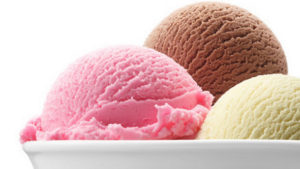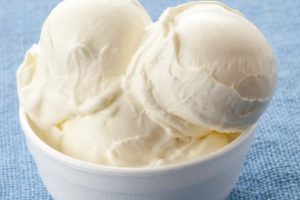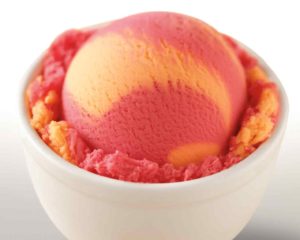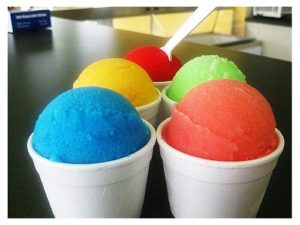By: Elizabeth Clark

Ice Cream. Source: http://www.dairyreporter.com/Markets/More-demand-for-ice-cream-with-functional-use-natural-ingredients
Summer is here, and it is certainly making its presence known. Temperatures have been soaring, and record highs are being reported worldwide. With all of this heat, how does one manage to stay cool? Technologies such as air conditioning, fans, and mist generators exist to help us stay cool externally. Additionally, one can stay cool by taking a “dip” in an, ocean, lake, or pool. But what about staying cool internally? One of the best strategies: consuming a “dip” of ice cream or other frozen dessert.
The frozen food section of a grocery store is truly a sight to behold. The freezer cases are stocked top to bottom with colorfully decorated containers featuring a variety of products such as ice cream, sorbets, fruit ice, gelato, frozen yogurt, and custard in just about every mouthwatering flavor imaginable. This plethora of products presents a puzzling thought: what are these products, and how do they differ from one another?
According to the Code of Federal Regulations (CFR), ice cream is defined as “a food produced by freezing, while stirring, a pasteurized milk consisting of optional dairy ingredients, caseinates, hydrolyzed milk proteins, and other safe and suitable non-milk derived ingredients” (21CFR135). Though many frozen milk-based products may fit this description, not all of them are legally permitted to be called ice cream. In order for a food product to boast the title of “ice cream”, it must meet the standard of identity set forth by the Food and Drug Administration (FDA) in the CFR. For ice cream, this means containing no less than 10% milkfat. A few exceptions to the standard of identity exist, but thankfully those are also outlined in the CFR. Likewise, the CFR also describes how to accurately calculate important values (such as milkfat or milk solids), just in case there happens to be any confusion surrounding those.

Custard. Source: http://www.coneyscustard.com/
Frozen custard is very similar to ice cream, but maintains a few fundamental differences to warrant the CFR distinguishing custard by a different standard of identity. What distinguishes frozen custard from ice cream? Egg yolks. Frozen custard “shall contain no less than 1.4% egg yolk solids by weight of the finished food”(21CFR135). Frozen custard may also be labeled as “French Ice Cream” or “French Custard Ice Cream.

Sherbet. Source: www.schwans.com
Sherbet is easily distinguishable from other frozen desserts in the freezer section due to its bright, flashy colors. Likewise, sherbet is set apart from other frozen desserts due to its composition. Sherbet contains optional fruit-characterizing as well as nonfruit-characterizing ingredients. Fruit-characterizing ingredients can include whole fruit, fruit juice, and even dried fruit. Nonfruit-containing ingredients can range from cocoa to artificial flavorings, and even includes distilled alcohol. What sets sherbet apart from ice cream and custard is that it contains no less than 1 percent and no more than 2 percent milkfat. So for those consumers watching their fat intake, sherbet is a wonderful option to satisfy their “sweet tooth”.

Water Ice. Source: https://twitter.com/parkerswaterice
Another frozen dessert that can be found in the freezer section is what is known as a water ice. Water ices are prepared from the same ingredients and in the same manner as sherbets. However, water ices do not need to be pasteurized nor do they include milk or egg ingredients (with the exception of egg white). Examples of water ice products include popsicles and Italian ice.
One popular product is missing from this discussion of frozen desserts, and that product is gelato. Fun fact: in the United States, there is no legal definition for gelato (21CFR135). Though gelato is commonly thought of as ice cream, Italians and gelato connoisseurs will argue that gelato is starkly different. True gelato has little to no overrun (a.k.a. the air that is whipped into ice cream to give it volume), which causes it to have a denser texture. Additionally, gelato is manufactured using 4-8% milkfat rather than the 10% milkfat required for ice cream (Thompson et al. 2009)(Marshall et al. 2003).

Gelato. Source: www.tazzatogo.com
The fact that frozen desserts are often lumped together under the term ice cream is a fallacy. Each of these products is as unique as the ingredients, textures, and flavors they contain. Despite their inherent differences, these frozen desserts all have one trait in common: they offer a sweet, tasty way to beat the summer heat!
References
Thompson KR, Chambers DH, Chambers Iv E (2009) Sensory characteristics of ice cream produced in the U.S.A. and Italy. J Sens Stud 24:396–414. doi: 10.1111/j.1745-459X.2009.00217.x
United States Food and Drug Administration (FDA) (2015) 21CFR135. In: CFR-Code Fed. Regul. Title 21. http://www.accessdata.fda.gov/scripts/cdrh/cfdocs/cfcfr/CFRSearch.cfm?CFRPart=135&showFR=1&subpartNode=21:2.0.1.1.23.2. Accessed 20 Sep 2016






Leave a Reply